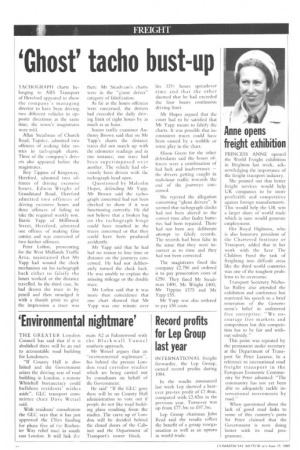'Ghost' tad° bust-up
Page 16

If you've noticed an error in this article please click here to report it so we can fix it.
TACHOGRAPH charts belonging to ARS Transport of Hereford appeared to show the company's managing director to have been driving two different vehicles in opposite directions at the same time, the town's" magistrates were told.
Allan Steadman of Church Road, Tupsley, admitted two offences of making false entries in tachograph charts. Three of the company's drivers also appeared before the magistrates.
Roy Tippins of Kingsway, Hereford, admitted two offences of driving excessive hours. Edwin Wright of Grandstand Road, Hereford admitted two offences of driving excessive hours and three offences of failing to take the required weekly rest. Barrie Yapp of Millbrook Street, Hereford, admitted one offence of making false entries and was convicted of two further offences.
Peter Loftus, prosecuting for the West Midlands Traffic Area, maintained that Mr Yapp had wound the clock mechanism on his tachograph back either to falsify the hours worked or the distance travelled. In the third case, he had drawn the trace in by pencil and then smudged it with a thumb print to give the impression a trace was
there. Mr Steadman's charts were in the "ghost driver"' category of falsification.
As far as the hours offences were concerned, the drivers had exceeded the daily driving limit of eight hours by as much as an hour.
Senior traffic examiner Anthony:Brown said that on Mr Yapp"s charts the distance traces did not match up with the odometer readings and in one instance, one trace had been superimposed over another. The vehicle had obviously been driven with the tachograph head open.
Questioned by Malcolm Hopes, defending Mr Yapp, Mr Brown said the tachograph concerned had not been checked to show if it was Functioning correctly. He did not believe that a broken lug on the tachograph hinge could have resulted in the traces concerned or that they could have been produced accidently.
Mr Yapp said that he had had no reason to lose time or distance on the journeys concerned. He had not deliberately turned the clock back. He was unable to explain the missing mileage or the double trace.
Mr Loftus said that it was more than coincidence that one chart showed that Mr Yapp was one minute over
his 121/2 hours spreadover time and that the other showed that he had exceeded the four hours continuous driving limit.
Mr Hopes argued that the court had to be satisfied that Mr Yapp meant to falsify the charts. It was possible that inconsistent traces could have been caused by a wobble or some play in the chart.
Alison Green for the other defendants said the hours offences were a combination of bad luck and inadvertance — the drivers getting caught in rush-hour traffic towards the end of the journeys concerned.
She rejected the allegation concerning "ghost drivers". It seemed that tachograph clocks had not been altered to the correct time after faulty batteries had been repaired. There had not been any deliberate attempt to falsify records. The records had been false in the sense that they were incorrect as to time and they had not been corrected.
The magistrates fined the company £2,750 and ordered it to pay prosecution costs of 250. They fined Mr Steadman £400, Mr Wright £400, Mr Tippins £175 and Mr Yapp £55.
Mr Yapp was also ordered to pay .£50 costs.




































































































